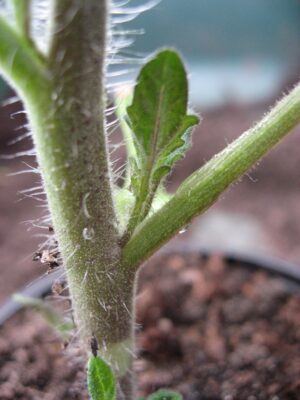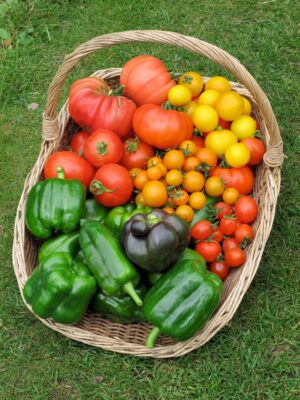It’s cold in Cold Aston and my two lovely daughters do a wonderful Stella Gibbons act in the same sort of northern accent you get on the Hovis advert – where the young lad pushes the bike up Gold Hill in Shaftesbury in Dorset. I have trouble propelling myself up that steep hill, let alone pushing a bike up there as well. These days mine’s electric by the way, a privilege of being a septuagenarian. It’s one of the few!
Well, it’s a lot warmer down in Dorset than it is in the upper reaches of the Cotswolds as my daughters will tell you, when they’re performing their Cold Comfort Farm routine. It’s all in the name, you see. We’re not called Cold Aston for nothing and the cool climate controls our gardening. We have a shorter growing season and we have to start later than those in the soft south, as we jealous northerners call the banana belt of the country. Seed packets seem geared towards warmer gardens, but I’m later. I sow parsnips in late March, not February, despite what it says on the packet.
The continual wet weather of 2024 cannot have escaped your attention. I strode over the fields the other day, well squelched to be exact, and looked at my neighbour’s bedraggled Cotswold sheep. A handsome breed, with ringlets that Jane Austin would have been really proud of. They were like dirty dishcloths after a chocolate-themed, two-year old’s party. I know. I’ve been there. The trouble is, you can’t put Cotswold sheep on a fast wash, or give them a warm bath.
This wet weather means that we will have to wait even longer than usual to sow our vegetable seeds and plant our onions and shallots outside, due to the waterlogged ground. This is where having a greenhouse pays dividends, because it’s warm and toasty in there. More importantly it’s dry. And now, I have two Hartley greenhouses to play with!
I may have mentioned, dear readers, that my first Hartley greenhouse was hijacked by the Best Beloved’s tomatoes. My pelargoniums never got a look in. In winter I am thankful for his tomatoes, because he makes and freezes home-made passata every summer, using the Rigamonti ‘Velox’ – available from Seeds of Italy. Home-grown tomato sauce livens up winter fare such as sausage and bean casserole. The bean of choice, which we dry and store, is a Borlotti named ‘Lamon’ – also from Seeds of Italy or Franchi Seeds. These red and cream bean seeds will be sown in the second half of April. They’re both budget busters!
However, it’s already time for me, or him indoors, to sow our tomato seeds once again. Sowing your own tomato seeds allows you to pick your own varieties, rather than having to put up with the one or two stocked by garden centres. Their plants often have blackened foliage caused by cold shock, because these frost-tender plants are shoved on to outdoor benches from Easter onwards. They suffer and, once tomato plants have had a cold shock, they rarely recover. Don’t put your tomato plants outside until early June, unless your garden is warmed by city air or close to the coast.

The best equipment for sowing tender seeds, ones that need 24-hour warmth to germinate, is the thermostatically controlled Vitopod Large Heated Propagator. It may seem expensive, but they last for many years and my two have earnt their keep ten times over because buying ready-grown tomato plants is expensive. One grafted tomato plant can set you back roughly a tenner per plant. A small, un-grafted plug will cost an average of four pounds. At those prices, your propagator will soon pay for itself. You’ll be able to use it for a wide variety of cuttings and seeds.
Tomato seeds germinate willingly and the following method works well. Use seed sowing compost and I do well with Dalefoot which is fluffy and warm. Write your labels first and then fill clean 9cm pots – about half to a quarter of an inch below the pot rim. Water the pots well and allow them to drain. Add the label and scatter the seeds VERY thinly over the compost. Lightly cover the seeds with a smattering of compost. Place in the propagator. Keep the lid on overnight, but remove it on fine days. Ventilate as needed: there are sliding wheels that allow air to flow through.
Tomato seeds usually begin to grow after a week or ten days, so your pots should not need watering until the first seedlings appear. Plunge your finger right in and, if the compost feels damp, leave well alone. Small seedlings and plants should not sit in damp compost, because it doesn’t encourage good root systems. Drier is better.
Once your tomato seedlings develop 3 – 4 true leaves gently prick them out into individual 9cm pots. Handle them by the lowest seed leaves – also known as the cotyledons. I usually use Melcourt’s compost with added John Innes at this stage. You can also sow peppers and aubergine seeds at the same time as your tomatoes and I begin in early March here.
By the time your tomato plants reach 8 – 12 inches, the roots should have reached the bottom of the small pot. Once this happens it’s time to transfer them into larger pots and supportive canes are added at this stage. Do use came toppers and small upended pots work well. The most important thing in the early stages is to remove the side shoots that spring up between the stem and the main leaves. (see picture) Pinch these out and allow each plant to develop 6 – 7 trusses.
We aren’t warm enough for outdoor tomatoes here, so all our tomatoes are grown under glass. Once the first flowers appear, begin to use watered on high potash tomato food once a week. This will encourage more flower.
Select AGM varieties, if possible, and we aim to grow a variety of shapes, sizes and colours. Our most abundant tomato is ‘Britain’s Breakfast’. It has ‘ballerina’ trusses of lemon-shaped red fruits on trusses that cover a foot or more in width. The fruit hangs like a skirt. One truss can give you 60 tasty tomatoes. My original seeds came from Lancashire-based Robinson’s, but they are now supplying seeds to other seed companies so there are plenty of suppliers.
My go-to, round red tomato is ‘Akron’ F1 and this hybrid seed has disease resistance and vigour – as do all F1s. It’s always worth paying more for F1 hybrids, when it comes to tomatoes. You should get 7 -8 tomatoes per truss from ‘Akron’ and it’s perfect for salads. Tomato blight is a problem under glass and outside, so we also grow ‘Mountain Magic’, a blight-resistant round red tomato. It has a zingy flavour and a high sugar content.

Beefsteak tomatoes are huge red jobs, so they have fewer fruits per truss, perhaps only 2 or 3. However, they are fleshy and they make the best passata of all. They also fry wonderfully well too. ‘Big Daddy’, another disease-resistant F1 variety, has done very well for us. We usually have 3 plants of this one.
I like to have oranges and yellows, because they look so attractive on the plate. ‘Orange Wellington’ F1 is a fleshy round orange-red tomato that bakes and eats well. This AGM variety can be grown under glass or outdoors. ‘Golden Sunrise’, another AGM, produces a later crop of smaller yellow fruits. ‘Sungold’ is an orange cherry tomato, although it does have a tendency to split if the watering’s erratic. I love ‘Tigerella’, another AGM, for its striped red and gold fruits. This tasty Greek variety yields heavily.
Last year I grew two new blight-resistant plum varieties and they both did well. ‘Bliss’ F1 has plum-shaped yellow tomatoes with faint white stripes. The flavour and texture are excellent and it has good disease resistance. It was bred by Henk van der Velde and launched by Burpee Europe. Burpees also launched a black plum tomato named ‘Black Moon’ F1, which I grew last year – more in hope than expectation. It did very well, although it needed picking once the fruit develops some red.
Essex-based Kings Seeds offer the best value for money, when it comes to all vegetable seeds, because they’ve largely stuck to selling seeds.
I am itching to pick my first ripe tomato – so I’d better get on and sow the seeds.



